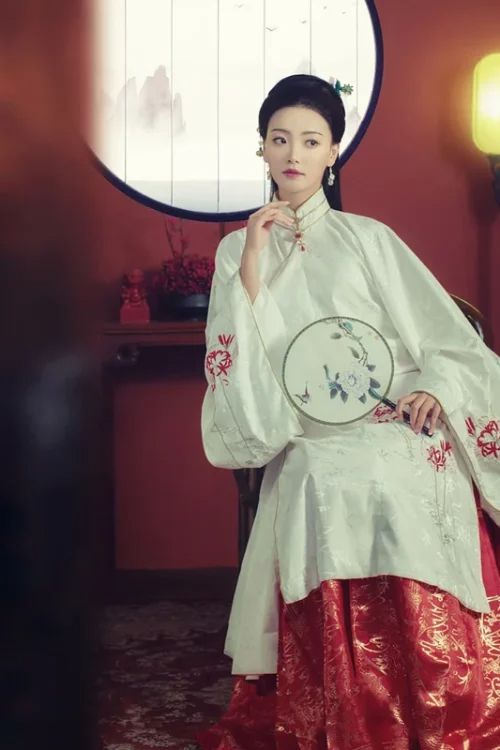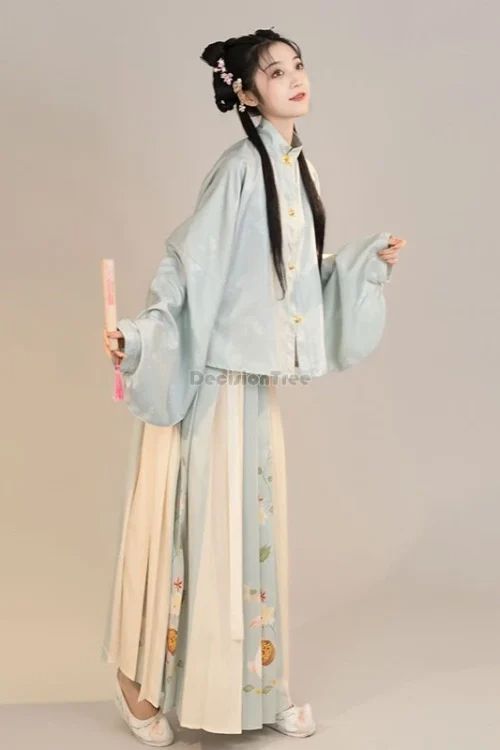The History and Evolution of Lantern Patterns on 汉服
The lantern pattern, a captivating motif deeply rooted in Chinese culture, has found its exquisite expression on the elegant garments of Hanfu, the traditional attire of the Han Chinese. Its origins can be traced back to ancient times, where lanterns illuminated festivals and celebrations, symbolizing prosperity and good fortune.

Introduction and Early Use
As Hanfu evolved through the dynasties, the lantern pattern became an integral part of its intricate designs. During the Han Dynasty, lanterns adorned with auspicious symbols were depicted on silk robes, representing the wearer’s hopes for a bright future. In the Tang Dynasty, the lantern pattern flourished, with lanterns of various shapes and sizes adorning the flowing sleeves and skirts of Hanfu.
Evolution During the Song 和 Ming Dynasties
The Song Dynasty witnessed a surge in the popularity of lantern patterns, particularly on women’s garments. Lanterns were often depicted in pairs, symbolizing harmony and marital bliss. The Ming Dynasty saw the lantern pattern reach its zenith, with lanterns of intricate designs and vibrant colors becoming a staple of Hanfu.
Cultural Significance
The lantern pattern not only added aesthetic appeal to Hanfu but also carried cultural significance. Lanterns were associated with the Mid-Autumn Festival, a time for family reunions and moonlit celebrations. Wearing Hanfu adorned with lantern patterns during this festival symbolized the wearer’s connection to tradition and their desire for a prosperous future.
Resurgence in Modern Times
In modern times, the lantern pattern has experienced a resurgence in popularity as Hanfu enthusiasts seek to revive the beauty and cultural significance of traditional Chinese attire. Contemporary Hanfu designers have reinterpreted the lantern pattern, incorporating it into modern designs while preserving its timeless appeal.
Legacy and Significance
The application of lantern patterns on Hanfu is a testament to the enduring legacy of Chinese culture. It represents the fusion of art, tradition, and symbolism, creating garments that are both visually stunning and deeply meaningful. As Hanfu continues to evolve, the lantern pattern will undoubtedly remain an integral part of its rich tapestry, connecting the past to the present and illuminating the future.
The Cultural Significance of Lantern Patterns in Hanfu
Lantern patterns, an integral part of Hanfu, the traditional clothing of the Han Chinese, hold profound cultural significance. These intricate designs, often featuring auspicious symbols and motifs, reflect the rich history, beliefs, and aesthetics of Chinese culture.

Origins and Symbolism
The origins of lantern patterns can be traced back to ancient times, when lanterns were used for illumination and decoration during festivals and rituals. Over time, these patterns evolved into a distinct art form, incorporating elements from nature, mythology, and folklore.
Common Motifs
One of the most common lantern patterns is the lotus flower, a symbol of purity, enlightenment, and rebirth. The lotus is often depicted with eight petals, representing the Eightfold Path of Buddhism. Other popular motifs include the phoenix, a mythical bird associated with good fortune and prosperity; the dragon, a symbol of power and wisdom; and the auspicious cloud, representing good luck and longevity.
Application on Hanfu
The application of lantern patterns on Hanfu varies depending on the garment’s style and occasion. Formal robes, such as those worn by officials and scholars, typically feature elaborate patterns woven into the fabric. These patterns often incorporate auspicious symbols and motifs, such as the dragon and phoenix, to convey the wearer’s status and authority.
In contrast, everyday Hanfu garments may feature simpler lantern patterns printed or embroidered onto the fabric. These patterns often depict scenes from nature, such as flowers, birds, and landscapes. They add a touch of elegance and beauty to the garment while reflecting the wearer’s connection to the natural world.
Cultural Expression Through Design
Beyond their aesthetic appeal, lantern patterns on Hanfu also serve as a form of cultural expression. They embody the values, beliefs, and aspirations of the Han Chinese people. By wearing Hanfu adorned with lantern patterns, individuals not only showcase their cultural heritage but also connect with the traditions and customs of their ancestors.
Resurgence and Modern Relevance
In recent years, there has been a resurgence of interest in Hanfu and its associated cultural practices. This has led to a renewed appreciation for lantern patterns, which are now being incorporated into a wide range of contemporary fashion and design. By preserving and promoting these traditional patterns, we not only honor our cultural heritage but also ensure its continued relevance in the modern world.
现代 Applications of Lantern Patterns in Hanfu Design
The lantern pattern, a traditional Chinese motif, has found renewed popularity in modern Hanfu design. This intricate pattern, inspired by the shape and structure of lanterns, adds a touch of elegance and cultural significance to contemporary Hanfu garments.

Design Characteristics and Versatility
The lantern pattern is characterized by its symmetrical, geometric design. It typically consists of a central circle or square surrounded by a series of concentric rings or petals. The pattern can be rendered in various colors and materials, from vibrant silks to delicate laces.
In Hanfu design, the lantern pattern is often used to create a sense of balance and harmony. It can be incorporated into the main fabric of the garment, such as the skirt or bodice, or used as an accent on sleeves, collars, or hems. The pattern’s versatility allows it to complement a wide range of Hanfu styles, from formal court robes to casual everyday wear.
Notable Applications in Contemporary Hanfu
One of the most striking applications of the lantern pattern in Hanfu design is the “lantern sleeve.” This type of sleeve is characterized by its wide, flowing shape, which resembles the shape of a lantern. Lantern sleeves can be made from sheer or opaque fabrics and often feature intricate embroidery or beading. They add a touch of drama and elegance to Hanfu garments, making them perfect for special occasions.
Another popular application of the lantern pattern is the “lantern skirt.” This type of skirt is made up of several layers of fabric, each cut into a lantern shape. When worn, the skirt creates a voluminous, flowing effect that is both visually appealing and comfortable to wear. Lantern skirts are often paired with fitted bodices or tops to create a balanced and flattering silhouette.
Cultural Significance in Modern Design
In addition to its aesthetic appeal, the lantern pattern also carries cultural significance. Lanterns have long been used in Chinese culture to symbolize light, hope, and good fortune. By incorporating the lantern pattern into Hanfu design, modern designers are paying homage to this rich tradition while creating garments that are both stylish and meaningful.
Preservation of Cultural Heritage
The application of lantern patterns in Hanfu design is a testament to the enduring appeal of traditional Chinese motifs. By incorporating these patterns into contemporary garments, designers are not only creating beautiful and unique pieces but also preserving and promoting Chinese cultural heritage. As Hanfu continues to gain popularity both in China and abroad, the lantern pattern is sure to remain a staple of this vibrant and evolving fashion trend.
Lantern pattern is a traditional Chinese pattern and if you are interested in this pattern and you want have a look on any other traditional Chinese patterns on Hanfus, please click our website:https://cheongsam.net/. Followings are hanfus with different motifs on, hope you love it~
